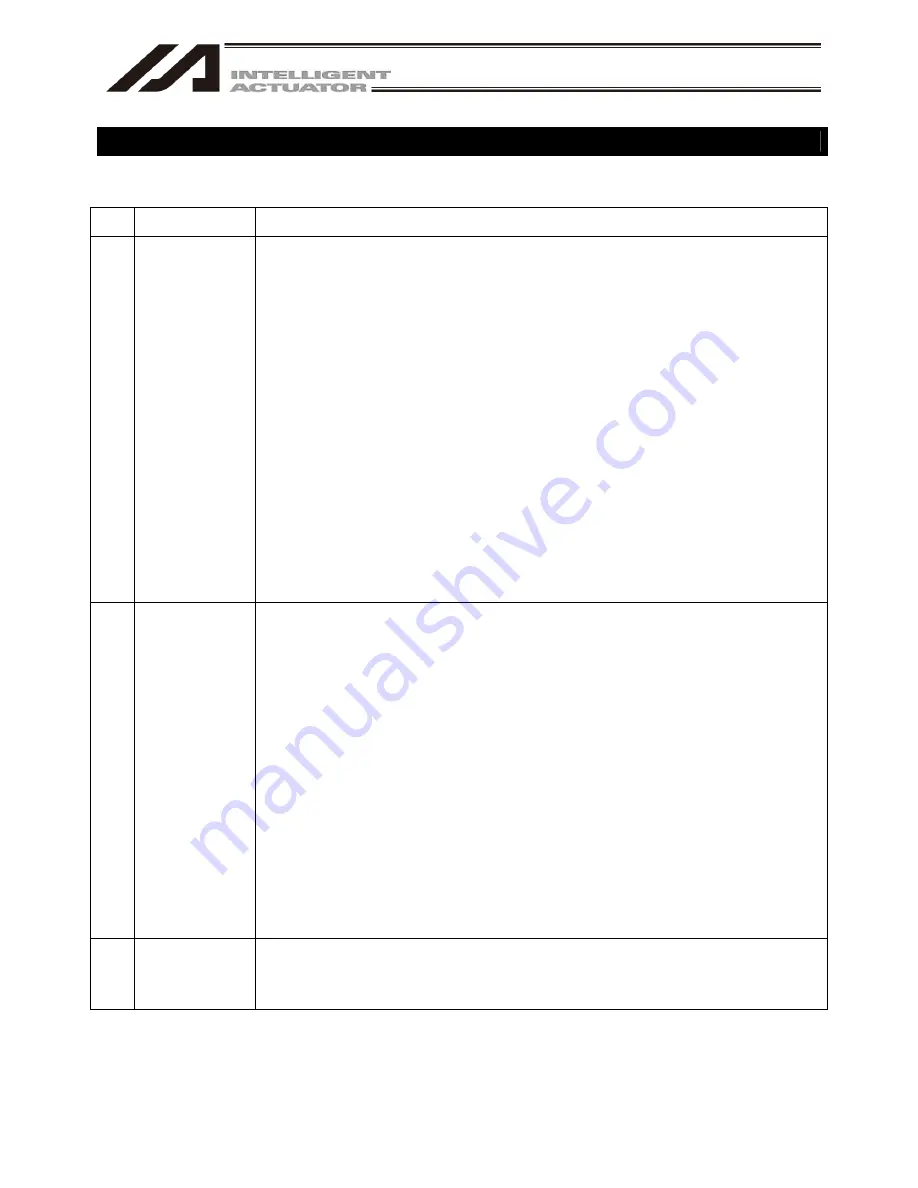
10
Safety Precautions for Our Products
The common safety precautions for the use of any of our robots in each operation.
NO.
Work Description
Precautions
1
Model
Selection
This product has not been planned and designed for the application where high level of
safety is required, so the guarantee of the protection of human life is impossible.
Accordingly, do not use it in any of the following applications.
1) Medical equipment used to maintain, control or otherwise affect human life or physical
health.
2) Mechanisms and machinery designed for the purpose of moving or transporting people
(For vehicle, railway facility or air navigation facility)
3) Important safety parts of machinery (Safety device, etc.)
Do not use the product outside the specifications. Failure to do so may considerably
shorten the life of the product.
Do not use it in any of the following environments.
1) Location where there is any inflammable gas, inflammable object or explosive
2) Place with potential exposure to radiation
3) Location with the ambient temperature or relative humidity exceeding the specification
range
4) Location where radiant heat is added from direct sunlight or other large heat source
5) Location where condensation occurs due to abrupt temperature changes
6) Location where there is any corrosive gas (sulfuric acid or hydrochloric acid)
7) Location exposed to significant amount of dust, salt or iron powder
8) Location subject to direct vibration or impact
For an actuator used in vertical orientation, select a model which is equipped with a brake.
If selecting a model with no brake, the moving part may drop when the power is turned
OFF and may cause an accident such as an injury or damage on the work piece.
2
Transportation
When carrying a heavy object, do the work with two or more persons or utilize equipment
such as crane.
When the work is carried out with 2 or more persons, make it clear who is to be the leader
and who to be the follower(s) and communicate well with each other to ensure the safety
of the workers.
When in transportation, consider well about the positions to hold, weight and weight
balance and pay special attention to the carried object so it would not get hit or dropped.
Transport it using an appropriate transportation measure. The actuators available for
transportation with a crane have eyebolts attached or there are tapped holes to attach
bolts. Follow the instructions in the instruction manual for each model.
Do not step or sit on the package.
Do not put any heavy thing that can deform the package, on it.
When using a crane capable of 1t or more of weight, have an operator who has
qualifications for crane operation and sling work.
When using a crane or equivalent equipments, make sure not to hang a load that weighs
more than the equipment’s capability limit.
Use a hook that is suitable for the load. Consider the safety factor of the hook in such
factors as shear strength. Also, check to make sure that the hook is free of damages.
Do not get on the load that is hung on a crane.
Do not leave a load hung up with a crane.
Do not stand under the load that is hung up with a crane.
3
Storage and
Preservation
The storage and preservation environment conforms to the installation environment.
However, especially give consideration to the prevention of condensation.
Store the products with a consideration not to fall them over or drop due to an act of God
such as earthquake.
Summary of Contents for IA-101-X-MW
Page 2: ......
Page 4: ......
Page 8: ......
Page 50: ...1 Before You Begin 42 1 4 Connection to Controller Fig 1 48 X SEL K J Type Controller...
Page 52: ...1 Before You Begin 44 Figure shows example of TT Fig 1 50 Table Top Actuator TT TTA...
Page 53: ...1 Before You Begin 45 Fig 1 51 X SEL KX JX Type Controller...
Page 62: ...1 Before You Begin 54 Fig 1 60 ASEL Type Controller USB Cable...
Page 63: ...1 Before You Begin 55 Fig 1 61 PSEL Type Controller USB Cable...
Page 189: ...9 Symbol Edit Window 181...
Page 251: ...13 How to Reset an Absolute Encoder 243 Fig 13 38 Arm Length 120 Reference Position...
Page 386: ...16 Appendix 378...
Page 391: ......
















































